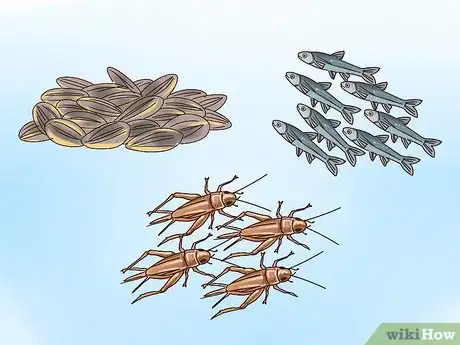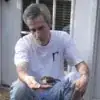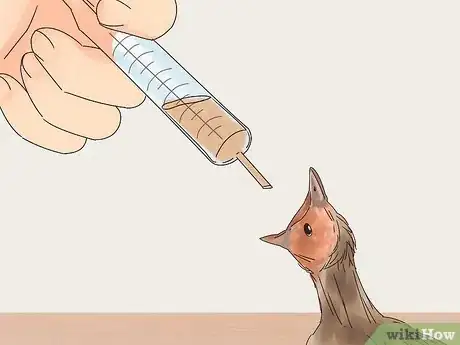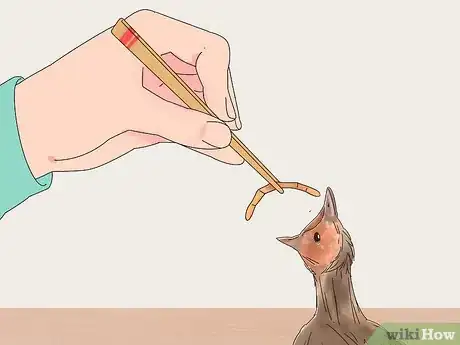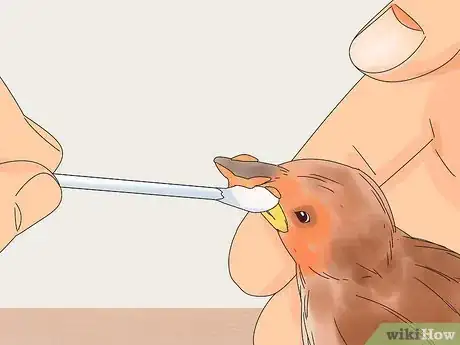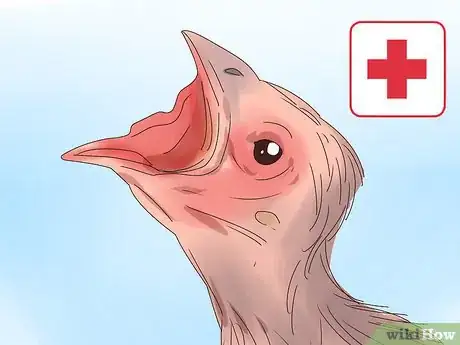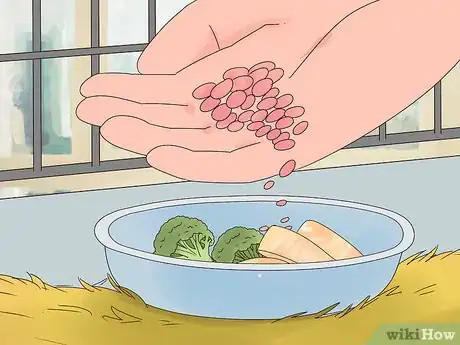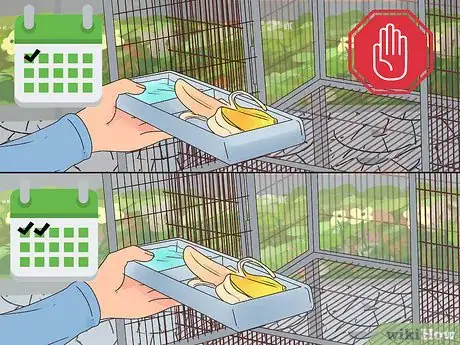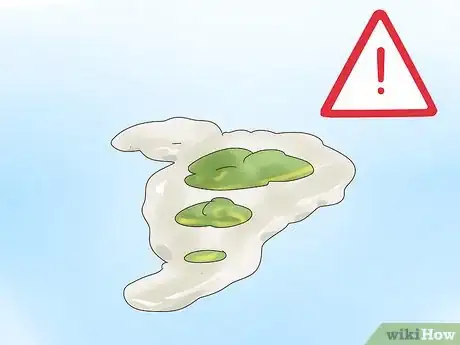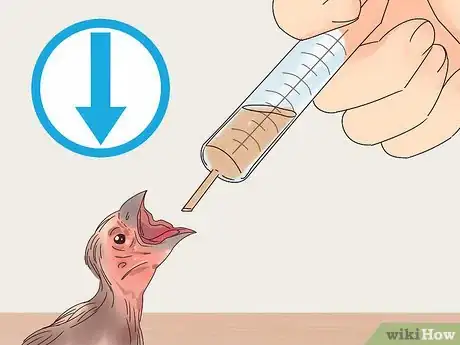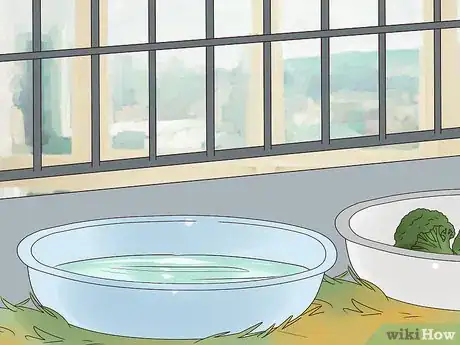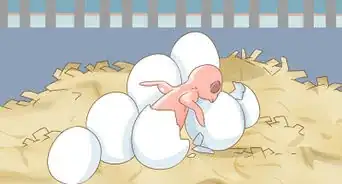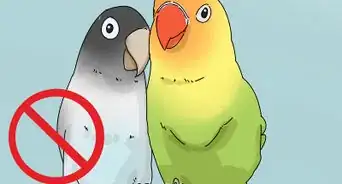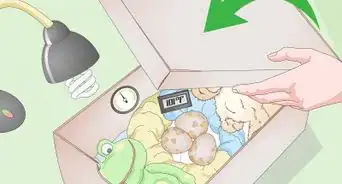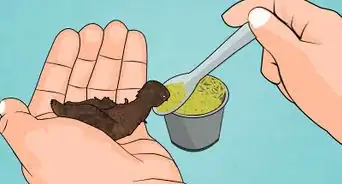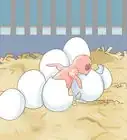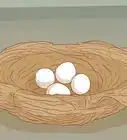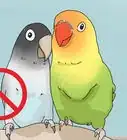This article was co-authored by Jeff Jones and by wikiHow staff writer, Amy Bobinger. Jeff Jones is a Bird Specialist based in Nashville, Tennessee. He is the writer of BirdOculars, a website dedicated to helping people become better birders. He has over 18 years of experience and specializes in feeding birds and wildlife. Jeff experiments to find ways to encourage birds he wants to study and his website help others to do the same.
There are 7 references cited in this article, which can be found at the bottom of the page.
This article has been viewed 57,294 times.
If you find a baby bird in the wild, you should almost always leave it alone or contact a wildlife rehabilitator, as keeping wild birds yourself can break state and federal laws. However, if you’ve already been nursing a wild baby bird, you’ll need to wean it off of hand-feedings before you can release it. Although the exact timeline and the foods you’ll offer will depend on the species of the bird, the general process of weaning is much the same no matter what type of bird you have.
Steps
Introducing New Foods
-
1Research the foods that are appropriate for the bird’s species. In order to determine what types of solid food to feed your baby bird, you’ll need to understand what it eats in the wild. Search online or look through wildlife books to find out the bird’s natural diet, or ask your veterinarian if you’re still not sure.[1]
- For instance, cardinals eat seeds, songbirds need a combination of insects and plant foods, and gulls or terns need crickets and small minnows.
- If you’re not sure what type of bird you have, consult a field guide or contact a wildlife rehabilitator.[2]
- In many cases, you can feed the baby bird softened dog or cat food, as long as it contains 30-40% protein.[3]
-
2Keep the baby bird well-fed with formula or mash as you transition. While it might seem like holding back formula will encourage the baby bird to start trying solid food, this can actually make weaning harder. When baby birds are hungry, they seek comfort and food from their mother. If the baby is well-fed, however, it will feel more confident and secure, and will be more likely to try out some of the new foods that you introduce.[4]
- Try offering a little solid food right after a formula feeding to encourage the baby bird to try it.
Advertisement -
3Add more solids to the bird’s mash as its feathers come in. In most cases, if a baby bird is featherless or still very fuzzy, it probably needs to be hand-fed, since its mother would likely still feed it in the wild. However, once its flight feathers start coming in, thicken its formula or mash a little so the baby bird can get used to tasting and processing slightly more solid food.[5]
- For instance, if you’re making mash out of dog or cat food that’s been soaked in water, you might add in 1-2 pieces of food that haven’t been soaked quite as long, so they retain a little of their texture. You can also buy commercial weaning pellets from a pet supply store. These pellets are nutritionally designed for baby birds.[6]
- This mimics how birds eat in the wild. As baby birds get older and start to eat more, the parents don’t have time to digest the food as much before giving it to the baby bird. The baby then gradually transitions to eating solid food.
Tip: If you’re feeding with a syringe, you may need to switch to a spoon with the sides bent up.
-
4Place a little solid food in a heavy food dish when the bird starts to peck. Although the timeline will vary depending on the species, baby birds will typically start to peck long before they’re ready to start weaning. Once you see the bird pecking at its feet and the bottom of its cage, offer it a little solid food, such as millet, suet cakes, rolled oats, or tiny pieces of insects, depending on what the species eats in the wild.[7]
- If you use a lightweight dish, the bird might tip it over, creating a big mess. Try using a heavy plastic lid or a dish made specifically for feeding birds.
- If you’re feeding the bird live mealworms, crush the insects’ heads with tweezers before you place them in the dish.
-
5Use tweezers to peck at the food if the baby bird needs encouragement. In the wild, a baby bird learns to eat solid food by watching the adults around it. If the bird doesn’t seem to know what to do with the food in its dish, take a pair of tweezers and tap at the dish. You can also pick up a piece of food with the tweezers and offer it to the baby bird the way its mother might.[8]
- To avoid startling the baby bird, only tap about once every second or so.
-
6Clean the baby bird’s face after it eats solid food. Baby birds can get food in their nostrils or eyes while they’re eating, which can lead to pain and discomfort or even infections. To avoid this, gently wipe the baby bird’s face with a cotton ball or a cotton swab each time you feed it.[9]
- This mimics the type of grooming a mother bird might do.
Transitioning to Solids
-
1Weigh the baby bird on a gram scale daily and record its weight. When you’re ready to start transitioning to solid food, it’s important to make sure the baby bird doesn’t lose too much weight. Weigh it every morning before you feed it and write down its weight. If you notice that its weight starts to drop, offer it a little more formula throughout the day.[10]
- Losing around 15-20% of the bird’s total body weight is normal, especially as the bird reaches its adult weight. However, if you notice any quick drops, there might be cause for concern. Add more formula to its diet and consult a vet if the bird starts to refuse food or act sick.[11]
-
2Check the bird’s health daily as well. Each day, as you weigh the bird, make sure that it looks healthy and alert. Its eyes should be shiny and bright, its mouth should be clean, and its feet should be plump. In addition, listen to the bird’s breathing. You shouldn’t hear any wheezing, clicking, or whistling.[12]
- If you notice any changes in the bird’s health, contact a vet or a wildlife rehabilitator.
-
3Keep solid foods in the cage regularly once the bird has all of its feathers. Although you should start introducing solid food early, by the time the baby bird has all of its feathers, it’s ready to start the weaning process in earnest. Provide a wide array of species-appropriate foods for the baby bird, with a variety of textures, flavors, and shapes.[13]
- For instance, you might offer the bird different fruits, vegetables, and seeds, if that fits with its diet.
- If you’re weaning a tern or a gull, place a shallow dish filled with live minnows in its enclosure.
-
4Skip the morning or mid-day feeding for one day to start. When you see the bird exploring its adult food, wait until the next day, then skip one of its early feedings and offer it solid food instead. The next day, give it all of its formula feedings, along with the solid food. Alternate doing this for a few days—skipping a feeding one day and giving it all of its formula feedings the next day.[14]
Tip: Make sure to always feed the bird formula for it’s last meal of the day until it's completely weaned. This should typically be the last feeding that you eliminate. Baby birds don’t eat overnight, so they need a good meal to hold them over while they’re sleeping.
-
5Monitor the baby bird’s poop for changes in the consistency. As you start introducing solid foods, keep an eye on the baby bird’s poop. The exact appearance will depend on the species, but it should remain relatively unchanged as you start offering solid food. If you notice any major changes in texture or color, wait a few days before making any more changes to the bird’s diet.[15]
- If the poop appears thin or watery, the bird might be getting too much liquid in its diet. Try reducing the amount of water in its formula.
-
6Reduce the amount of formula you’re giving in the early feedings. Once the bird starts getting used to the solid food, gradually reduce the amount of formula or mash you’re giving it during its morning and mid-day feedings. However, don’t eliminate them completely until you’re sure the baby bird is getting all the food it needs from its adult diet.[16]
- Try giving the baby bird about 3/4 as much formula as you normally would, for instance. After a few days, give it 3/4 of that amount, and so on.
-
7Add a water dish to the cage when you eliminate a formula feeding. While the bird is being formula fed, it doesn’t need to have access to water, since it gets most of its water intake from its food. Once you’re ready to start cutting out one of its formula feedings, though, the bird will need to have water available to make up the difference.[17]
- Baby birds can easily drown in a water dish, so it’s best not to include one in the cage until it’s older.
- If the water in your dish is deeper than about 1 in (2.5 cm), place smooth rocks in the dish as a perch.
-
8Drop to 1 night-time feeding, then none, as the bird starts to reject the formula. Typically, birds will start to prefer solid food and will show less interest in formula. The baby bird may refuse the formula altogether, it might only eat a little, or it might regurgitate the formula shortly after you feed it. As this starts to occur, eliminate the daytime feedings, only offering the bird formula at the end of the day. Stop hand-feeding the bird entirely when it no longer wants any formula.[18]
- Continue monitoring the baby bird’s weight. You may need to add back in an occasional supplemental formula as the bird’s system adjusts to eating all supplemental food.
Tip: If the baby bird changes to a new home within a few weeks of being weaned, it might benefit from being formula-fed for a few meals as it adjusts to its new location. In addition, it’s a good bonding experience for the bird and its new owner.
Community Q&A
-
QuestionI'm using cat food to feed it, will that work?
 Community AnswerCat food is a good choice, but kitten food can be better. Soaking the cat food helps it go down. It is good to change up the bird's diet a bit. If you know what bird it is, look at what that bird eats in the wild. Does it eat fruit? Then cut up soft fruits into small pieces to feed it. You can give it a mix of food the bird eats in the wild and soaked cat food.
Community AnswerCat food is a good choice, but kitten food can be better. Soaking the cat food helps it go down. It is good to change up the bird's diet a bit. If you know what bird it is, look at what that bird eats in the wild. Does it eat fruit? Then cut up soft fruits into small pieces to feed it. You can give it a mix of food the bird eats in the wild and soaked cat food. -
QuestionHow do I make a bird feel at home?
 michael jonesCommunity AnswerMake sure it has a lot of sunlight, warmth, companionship, company, toys, food, water, and then just a nice big cage. Try not to be noisy on the first week of having it and make sure you talk to the bird often and interact with it.
michael jonesCommunity AnswerMake sure it has a lot of sunlight, warmth, companionship, company, toys, food, water, and then just a nice big cage. Try not to be noisy on the first week of having it and make sure you talk to the bird often and interact with it. -
QuestionWhere can I take a baby robin?
 Community AnswerCheck it for injuries, then call the RSPCA or ASPCA or any other animal welfare organization in your area. Tell them if the bird is hurt and they will either advise you on where to go, or send someone out to you to collect the bird.
Community AnswerCheck it for injuries, then call the RSPCA or ASPCA or any other animal welfare organization in your area. Tell them if the bird is hurt and they will either advise you on where to go, or send someone out to you to collect the bird.
Things You’ll Need
- Formula or mash
- Solid food appropriate for the bird’s species
- Shallow food and water bowls
- Tweezers (optional)
- Gram scale
- Notebook and pen
Warnings
- Check the laws in your area before you attempt to rescue or raise a baby bird. It may not be legal for you to rehabilitate a wild bird at all.⧼thumbs_response⧽
References
- ↑ http://www.birds.cornell.edu/crows/babycrow.htm
- ↑ Jeff Jones. Bird Specialist. Expert Interview. 13 May 2021.
- ↑ http://www.starlingtalk.com/babycare.htm
- ↑ http://www.exoticpetvet.com/weaning-baby-birds.html
- ↑ https://theparrotuniversity.com/arthandfeeding3
- ↑ http://www.wildlifehotline.com/wp-content/uploads/2012/02/NonNative-Birds-How-To.pdf
- ↑ http://www.wildlifehotline.com/wp-content/uploads/2012/02/NonNative-Birds-How-To.pdf
- ↑ http://www.wildlifehotline.com/wp-content/uploads/2012/02/NonNative-Birds-How-To.pdf
- ↑ http://www.wildlifehotline.com/wp-content/uploads/2012/02/NonNative-Birds-How-To.pdf
- ↑ http://www.exoticpetvet.com/weaning-baby-birds.html
- ↑ https://theparrotuniversity.com/arthandfeeding3
- ↑ https://theparrotuniversity.com/arthandfeeding3
- ↑ https://animals.mom.me/how-to-get-wild-baby-birds-to-eat-on-their-own-12256917.html
- ↑ https://theparrotuniversity.com/arthandfeeding3
- ↑ https://theparrotuniversity.com/arthandfeeding3
- ↑ https://theparrotuniversity.com/arthandfeeding3
- ↑ http://www.exoticpetvet.com/weaning-baby-birds.html
- ↑ http://www.exoticpetvet.com/weaning-baby-birds.html
- ↑ https://theparrotuniversity.com/arthandfeeding3
